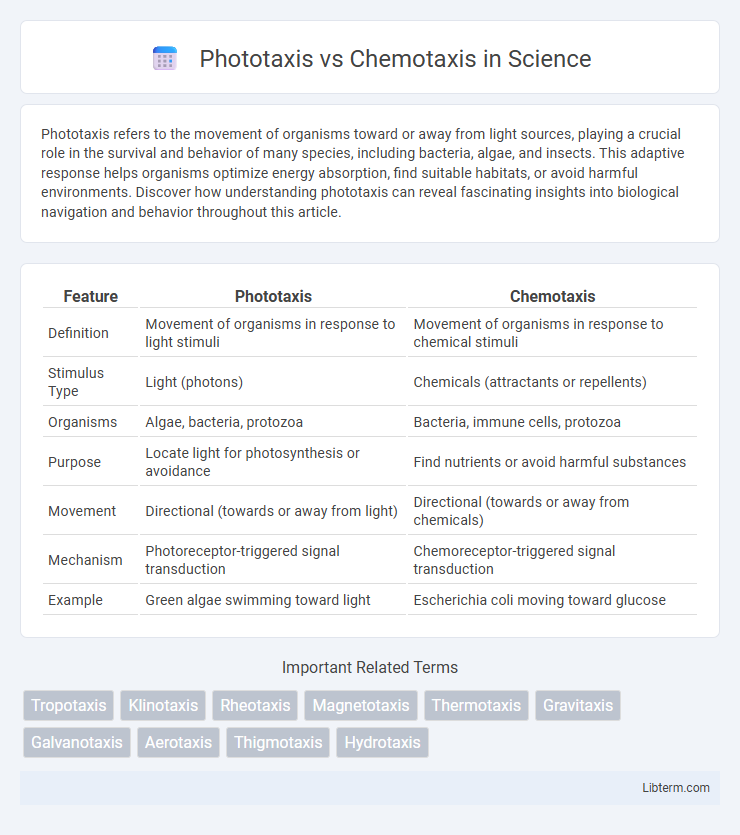Phototaxis refers to the movement of organisms toward or away from light sources, playing a crucial role in the survival and behavior of many species, including bacteria, algae, and insects. This adaptive response helps organisms optimize energy absorption, find suitable habitats, or avoid harmful environments. Discover how understanding phototaxis can reveal fascinating insights into biological navigation and behavior throughout this article.
Table of Comparison
| Feature | Phototaxis | Chemotaxis |
|---|---|---|
| Definition | Movement of organisms in response to light stimuli | Movement of organisms in response to chemical stimuli |
| Stimulus Type | Light (photons) | Chemicals (attractants or repellents) |
| Organisms | Algae, bacteria, protozoa | Bacteria, immune cells, protozoa |
| Purpose | Locate light for photosynthesis or avoidance | Find nutrients or avoid harmful substances |
| Movement | Directional (towards or away from light) | Directional (towards or away from chemicals) |
| Mechanism | Photoreceptor-triggered signal transduction | Chemoreceptor-triggered signal transduction |
| Example | Green algae swimming toward light | Escherichia coli moving toward glucose |
Introduction to Taxis Behavior
Taxis behavior encompasses the directed movement of organisms in response to specific stimuli, essential for survival and adaptation. Phototaxis involves movement toward or away from light sources, commonly observed in aquatic microorganisms and insects, aiding in optimal environmental positioning. Chemotaxis refers to movement directed by chemical gradients, crucial for processes like bacterial infection, immune responses, and nutrient acquisition.
Defining Phototaxis
Phototaxis refers to the movement of organisms toward or away from light stimuli, enabling them to optimize energy absorption and environmental conditions for survival. This behavior is primarily observed in motile microorganisms such as algae and bacteria, which navigate light gradients to enhance photosynthesis or avoid harmful radiation. Unlike chemotaxis, which is driven by chemical signals, phototaxis specifically involves light as the directional cue affecting cellular locomotion.
Defining Chemotaxis
Chemotaxis is the directed movement of cells or organisms toward or away from chemical stimuli, guided by concentration gradients of specific molecules in their environment. Unlike phototaxis, which responds to light, chemotaxis is crucial for processes such as immune response, wound healing, and bacterial navigation toward nutrients or away from toxins. This molecular sensing enables precise cellular positioning essential for survival and adaptation in diverse biological contexts.
Key Differences Between Phototaxis and Chemotaxis
Phototaxis is the movement of organisms in response to light stimuli, while chemotaxis involves movement toward or away from chemical signals. Phototactic responses typically guide photosynthetic organisms like algae toward optimal light for energy production, whereas chemotaxis is crucial for bacteria and immune cells to locate nutrients or infection sites. The underlying mechanisms differ; phototaxis relies on photoreceptor proteins sensitive to light wavelengths, whereas chemotaxis depends on chemoreceptor proteins detecting specific chemical gradients.
Mechanisms Underlying Phototaxis
Phototaxis involves the movement of organisms toward or away from light sources, driven primarily by specialized photoreceptor proteins such as rhodopsins and flavoproteins that detect light intensity and wavelength. Signal transduction pathways convert light stimuli into cellular responses by modulating motor functions like flagellar rotation or ciliary beating for directional movement. This mechanism contrasts with chemotaxis, which relies on chemoreceptors detecting chemical gradients rather than light cues.
Mechanisms Underlying Chemotaxis
Chemotaxis involves cells detecting and moving toward chemical gradients through specialized receptors like G-protein coupled receptors (GPCRs) that trigger intracellular signaling pathways. These pathways regulate actin cytoskeleton remodeling via molecules such as PI3K, Rac, and Rho, enabling directional motility. Signal transduction cascades integrate external chemical cues, allowing cells like neutrophils and bacteria to navigate complex environments effectively.
Examples of Organisms Exhibiting Phototaxis
Phototaxis is the movement of organisms toward or away from light sources, exemplified by green algae such as Chlamydomonas, which swim toward light to optimize photosynthesis. Euglena, a unicellular protist, also demonstrates positive phototaxis to enhance energy production through its chloroplasts. Certain bacteria, like purple non-sulfur bacteria, exhibit phototaxis to position themselves in optimal light environments for photosynthetic activity.
Examples of Organisms Exhibiting Chemotaxis
Escherichia coli is a well-known bacterium that exhibits chemotaxis by moving toward nutrients like sugars and amino acids. Another example is the amoeba Dictyostelium discoideum, which migrates toward cyclic AMP signals during aggregation. Sperm cells also demonstrate chemotaxis by navigating chemical gradients to locate the egg for fertilization.
Biological Significance of Taxis Responses
Phototaxis enables organisms like algae and bacteria to move toward or away from light, optimizing photosynthesis and survival in fluctuating environments. Chemotaxis allows cells such as neutrophils and bacteria to navigate chemical gradients, essential for processes like immune defense and nutrient acquisition. Both taxis responses play crucial roles in adaptation, resource localization, and maintaining homeostasis in diverse biological systems.
Applications and Future Research in Taxis Studies
Phototaxis and chemotaxis are critical in fields such as robotics, environmental monitoring, and targeted drug delivery, where understanding organisms' responses to light and chemical gradients informs the design of adaptive systems. Emerging research explores genetic manipulation and synthetic biology to enhance directional sensitivity, enabling precise navigation in micro-robots and improved biosensors. Future studies aim to integrate multi-taxis responses for complex environmental interactions, advancing applications in tissue engineering and autonomous bio-hybrid devices.
Phototaxis Infographic

 libterm.com
libterm.com